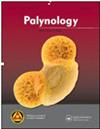Valvaeodinium hymenosynypha (Morbey) comb. nov., a dinoflagellate cyst from the uppermost Triassic and lowermost Jurassic (Rhaetian and Hettangian) of Europe
IF 1.3
4区 地球科学
Q3 PALEONTOLOGY
引用次数: 1
Abstract
Abstract Cymatiosphaera hymenosynypha Morbey 1975, previously recorded from the Rhaetian Westbury Formation in the United Kingdom, occurs in Triassic–Jurassic boundary strata from Denmark. From the present study it is clear that this small, finely reticulate, ellipsoidal, two-layered palynomorph is not a prasinophyte, but a dinoflagellate cyst with a combination apical/intercalary archaeopyle (type tAtI) which involves three apical plates plus one intercalary plate. This cavate cyst is morphologically similar but not identical to Valvaeodinium hanneae Piasecki 2001 from the uppermost Bathonian to lower Callovian of East Greenland, and it is therefore here transferred to Valvaeodinium, as Valvaeodinium hymenosynypha (Morbey) Lindström comb. nov. The appearance of Valvaeodinium hymenosynypha in Rhaetian strata in the Danish Basin suggests that the lineage of cavate Valvaeodinium cysts originated in the Late Triassic alongside a chorate species of the genus. Valvaeodinium hymenosynypha seems to have survived just barely past the end-Triassic mass extinction as it is also present in the earliest Hettangian.处女膜厚叶蜡藻(Morbey)梳。nov.,一个来自欧洲最上三叠纪和最下侏罗纪(雷提阶和荷塘阶)的甲藻囊肿
摘要hymenosynypha Morbey Cymatisphaera 1975,先前记录于英国Rhaetian Westbury组,产于丹麦三叠纪-侏罗纪边界地层。从目前的研究中可以清楚地看出,这种小的、细网状的、椭圆形的、两层的孢子虫形态不是一种前生植物,而是一种甲藻囊肿,其具有一个顶端/翼间古塔组合(tAtI型),包括三个顶端板加一个翼间板。该空腔囊肿在形态上与Valvaeodinium hanneae Piasecki 2001相似,但不完全相同,从东格陵兰最上层的巴通阶到下卡洛维阶,因此在这里被转移到Valvaeo迪尼um,称为Valvaeodinium hymenosynypha(Morbey)Lindström comb。nov.在丹麦盆地的Rhaetian地层中出现的Valvaeodinium hymenosynypha表明,洞穴状Valvaeo迪尼um囊肿的谱系起源于三叠纪晚期,与该属的一个chorate物种一起。处女膜虫Valvaeodinium hymenosynypha似乎在三叠纪末大灭绝后才幸存下来,因为它也存在于最早的荷塘阶。
本文章由计算机程序翻译,如有差异,请以英文原文为准。
求助全文
约1分钟内获得全文
求助全文
来源期刊

Palynology
地学-古生物学
CiteScore
3.40
自引率
26.70%
发文量
48
审稿时长
>12 weeks
期刊介绍:
Palynology is an international journal, and covers all aspects of the science. We accept papers on both pre-Quaternary and Quaternary palynology and palaeobotany. Contributions on novel uses of palynology, review articles, book reviews, taxonomic studies and papers on methodology are all actively encouraged.
 求助内容:
求助内容: 应助结果提醒方式:
应助结果提醒方式:


